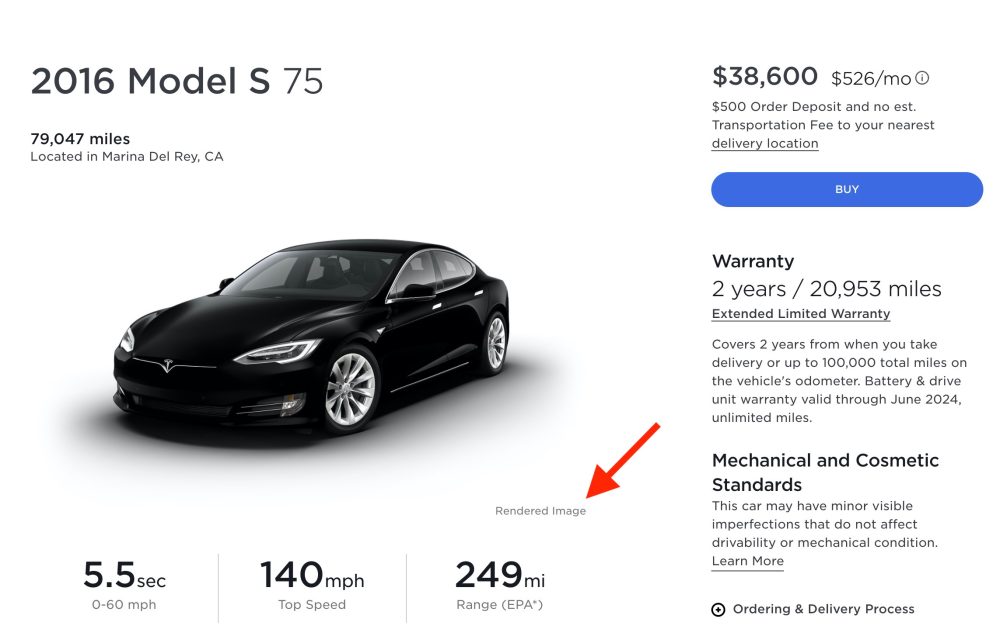
Tesla has once again changed its used car policy. It is reverting back to not sharing pictures of its used vehicles for sale.
Since Tesla doesn’t use the dealer model, it has arguably the greatest hold on the used car market for its own vehicles.
It gets a steady flow of used vehicles from leases ending and Tesla owners upgrading to the latest models.
Over the years, Tesla has made several changes to its used car program, previously pre-owned certified, or remarketed vehicles.
In 2017, Tesla introduced a new kind of warranty for certified pre-owned cars (CPO) that included a while refurbishing process.
At the time, the biggest issue is that Tesla didn’t share actual pictures of the used vehicles and instead only shared “rendered images”:

Tesla later allowed owners to actually request pictures of the used vehicles before buying them.
It was around the same time Tesla stopped “refurbishing” its used cars and instead moved to only perform a 70-point mechanical inspection and cleaning the vehicles.
Now, Tesla has apparently changed its policy, and it again doesn’t share actual pictures of used cars for sale until buyers place a non-refundable deposit and pay a transportation fee.
A former Tesla employee who is trying to buy a used Model S directly from the automaker shared with Electrek the following email he received from Tesla today:
“Hi [redacted], effective last night, Tesla is no longer posting actual photos of the vehicles and instead are doing stricter guidelines around cosmetic wear and expectations of wear and tear. Please see the following guidelines. Let me know if you have any questions. Thanks!”
Here are the new “stricter guidelines” about mechanical cosmetic conditions that the Tesla employee referenced:
Mechanical and Cosmetic Standards
Every used Tesla has passed an internal inspection and may undergo light repairs to be prepared for sale. Normal wear and tear indicative of the age and mileage of the car should be expected.
Mechanical Condition
Every used Tesla meets or exceeds Tesla’s Mechanical Standards as outlined below:
- No evidence of structural repairs
- Tires (5/32″ minimum)
- Brake pads (6 mm minimum)
Components inspected for functionality:
- Autopilot (if equipped)
- Displays
- Power-operated components
- Steering and suspension components
- Powertrain system
- Vehicle braking system
- Exterior lighting systems
- Driver controls
- Safety restraint systems
- Charging system and equipment functionality
Cosmetic Condition
Cosmetic wear and tear is typical of a used car and does not affect the functionality of the car. Your car will exhibit cosmetic wear and tear that includes, but is not limited to, the following:
Painted Panels
- Scratches up to 1″
- Dents up to 0.5″
- Rock chips
Unpainted Panels or Exterior Trim
- Scratches up to 3″
Glass
- Rock chips up to 1″
- Scratches
Wheels
- Rash up to 0.5″
Interior
- Signs of usage on upholstery and interior panels such as markings, discoloration, small tears or stains up to 1″
- Signs of usage on entry and exit points
Rubber Seals and Trim
- Damage of rubber not affecting function
Electrek’s Take
Come on Tesla. This is below you.
Those “stricter guidelines” are way too relaxed to charge a deposit on the vehicle without seeing actual pictures.
You won’t know until you see it in person if it has scratches up to 1″ on painted panels and 3″ on trims? Upholstery tears of up to 1″?
That doesn’t make sense.
To be fair, you can still just go to your local store, but then you are limited to the inventory they have there if they have any.
I went through Tesla’s used car buying experience a few years ago, and the vehicles were limited in my region and Tesla had to transport the car from another store.
Tesla really just needs to post actual pictures of the vehicles and their defects and damages on the website — like virtually every other car dealers — and let the buyers make the most informed decision they can.
What do you think? Let us know in the comment section below.
Subscribe to Electrek on YouTube for exclusive videos and subscribe to the podcast.
Author: Fred Lambert
Source: Electrek



